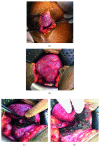Cholecystectomy of an Intrahepatic Gallbladder in an Ectopic Pelvic Liver: A Case Report and Review of the Literature
- PMID: 29225990
- PMCID: PMC5684543
- DOI: 10.1155/2017/3568768
Cholecystectomy of an Intrahepatic Gallbladder in an Ectopic Pelvic Liver: A Case Report and Review of the Literature
Abstract
Introduction: Ectopic pelvic liver is an exceedingly rare condition usually resulting after repair of congenital abdominal wall defects. Intrahepatic gallbladder is another rare condition predisposing patients to cholelithiasis and its sequelae. We describe a cholecystectomy in a patient with an intrahepatic gallbladder in a pelvic ectopic liver.
Presentation of case: A 33-year-old woman with a history of omphalocele repair as an infant presented with signs and symptoms of symptomatic cholelithiasis and chronic cholecystitis, however, in an unusual location. After extensive workup and symptomatic treatment, cholecystectomy was recommended and performed via laparotomy and hepatotomy using microwave technology for parenchymal hepatic transection.
Discussion: Given the rare combination of an intrahepatic gallbladder and an ectopic pelvic liver, advanced surgical techniques must be employed for cholecystectomies, in addition to involvement of hepatobiliary experienced surgeons due to the distortion of the biliary and hepatic vascular anatomy.
Conclusion: Cholecystectomy by experienced hepatobiliary surgeons is a safe and effective treatment for cholecystitis in patients with intrahepatic gallbladders in ectopic pelvic livers.
Figures





References
Publication types
LinkOut - more resources
Full Text Sources
Other Literature Sources
Research Materials

